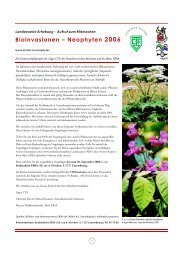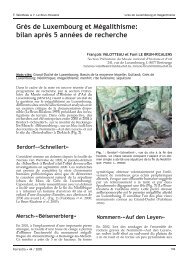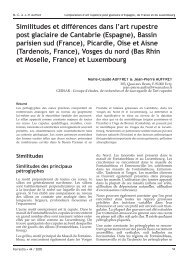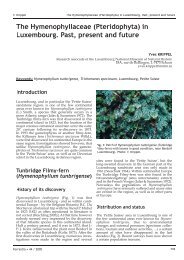Genetic variation in an isolated population of Hymenophyllum ...
Genetic variation in an isolated population of Hymenophyllum ...
Genetic variation in an isolated population of Hymenophyllum ...
Create successful ePaper yourself
Turn your PDF publications into a flip-book with our unique Google optimized e-Paper software.
G. Coll<strong>in</strong>g & S. Herm<strong>an</strong>t <strong>Genetic</strong> <strong>variation</strong> <strong>in</strong> <strong>an</strong> <strong>isolated</strong> <strong>population</strong> <strong>of</strong> <strong>Hymenophyllum</strong> tunbrigense<br />
<strong>Genetic</strong> <strong>variation</strong> <strong>in</strong> <strong>an</strong> <strong>isolated</strong> <strong>population</strong> <strong>of</strong><br />
<strong>Hymenophyllum</strong> tunbrigense<br />
Introduction<br />
We studied the genetic structure <strong>of</strong> <strong>an</strong> <strong>isolated</strong><br />
<strong>population</strong> <strong>of</strong> the extremely rare fi lmy fern <strong>Hymenophyllum</strong><br />
tunbrigense that occurs <strong>in</strong> the s<strong>an</strong>dstone<br />
area near Berdorf <strong>in</strong> Eastern Luxembourg. We<br />
sampled a total <strong>of</strong> 20 leaves along 3 tr<strong>an</strong>sects <strong>in</strong> a<br />
gorge conta<strong>in</strong><strong>in</strong>g the largest known Luxembourg<br />
<strong>population</strong> (Figs 1; 2). Pl<strong>an</strong>ts at three rock faces<br />
were considered as diff erent sub<strong>population</strong>s. The<br />
genetic <strong>variation</strong> among samples was tested us<strong>in</strong>g<br />
the RAPD method (Fig. 3).<br />
Fig. 1: Sampl<strong>in</strong>g <strong>of</strong> <strong>Hymenophyllum</strong> tunbrigense leaves<br />
<strong>in</strong> a large s<strong>an</strong>dstone gorge near Berdorf. Photo: Mnhnl.<br />
Ferr<strong>an</strong>tia • 44 / 2005<br />
Guy COLLING & Sylvie HERMANT<br />
Musée national d’histoire naturelle, Service biologie des <strong>population</strong>s<br />
25, rue Münster, L-2160 L-2160 Luxembourg<br />
Luxembourg<br />
guy.coll<strong>in</strong>g@mnhn.lu<br />
Height (m)<br />
Y (m)<br />
5<br />
4<br />
3<br />
2<br />
1<br />
0<br />
0 2 4 6 8<br />
X (m)<br />
Fig. 2: Schematic representation <strong>of</strong> the tr<strong>an</strong>sect sampl<strong>in</strong>g<br />
<strong>of</strong> leaves <strong>of</strong> H. tunbrigense <strong>in</strong> the rock face shown<br />
on Fig. 1. X: dist<strong>an</strong>ce from <strong>an</strong> arbitrary start<strong>in</strong>g po<strong>in</strong>t.;<br />
Y: height above same arbitrary start<strong>in</strong>g po<strong>in</strong>t.<br />
Fig. 3: Electrophoresis gel show<strong>in</strong>g RAPD b<strong>an</strong>d patterns<br />
from three dist<strong>in</strong>ct sub<strong>population</strong>s <strong>of</strong> <strong>Hymenophyllum</strong><br />
tunbrigense. Each column corresponds to one <strong>in</strong>dividual.<br />
89
G. Coll<strong>in</strong>g & S. Herm<strong>an</strong>t <strong>Genetic</strong> <strong>variation</strong> <strong>in</strong> <strong>an</strong> <strong>isolated</strong> <strong>population</strong> <strong>of</strong> <strong>Hymenophyllum</strong> tunbrigense<br />
90<br />
Table 1: Summary <strong>of</strong> <strong>an</strong>alysis <strong>of</strong> molecular vari<strong>an</strong>ce (AMOVA). Pl<strong>an</strong>ts represented 3 sub<strong>population</strong>s <strong>of</strong><br />
<strong>Hymenophyllum</strong> tunbrigense. The <strong>an</strong>alysis is based on RAPD phenotypes consist<strong>in</strong>g <strong>of</strong> 24 b<strong>an</strong>d<br />
states. Levels <strong>of</strong> signifi c<strong>an</strong>ce are based on 1000 iteration steps.<br />
Level <strong>of</strong> <strong>variation</strong> df Vari<strong>an</strong>ce component<br />
RAPD <strong>variation</strong> <strong>of</strong> <strong>population</strong>s<br />
<strong>an</strong>d gene fl ow<br />
There was strong genetic diff erentiation (RAPD<br />
pa pa pa pa erns) erns) among sub<strong>population</strong>s (24% <strong>of</strong> total<br />
<strong>variation</strong>) (P (P < 0.001) (Tab. 1). The strong genetic<br />
<strong>variation</strong> among sub<strong>population</strong>s <strong>an</strong>d the me<strong>an</strong><br />
number <strong>of</strong> <strong>in</strong>dividuals exch<strong>an</strong>ged between<br />
sub<strong>population</strong>s per per generation generation (N<br />
(N = 0.78)<br />
em<br />
<strong>in</strong>dicates that that gene gene fl fl ow ow between between sub<strong>population</strong>s<br />
sub<strong>population</strong>s<br />
is low. The pairwise genetic dist<strong>an</strong>ces (Phi<br />
ST) were<br />
signifi c<strong>an</strong>t between all sub<strong>population</strong>s (P (P < < 0.001).<br />
0.001).<br />
UPGMA cluster <strong>an</strong>alysis based on Nei’s dist<strong>an</strong>ces<br />
between RAPD phenotypes clearly separated the<br />
three sub<strong>population</strong>s sub<strong>population</strong>s (Fig. (Fig. 4). 4). A A possible possible explaexpla-<br />
nation for for the the observed observed genetic genetic diff diff erentiation is is a<br />
restricted dispersal <strong>of</strong> the spores (Fig. 5).<br />
Conclusions<br />
Our results show that the three sub<strong>population</strong>s<br />
form<strong>in</strong>g together the largest Luxembourg<br />
Absolute % P<br />
Among sub<strong>population</strong>s 2 0.939 24.27
G. Coll<strong>in</strong>g & S. Herm<strong>an</strong>t <strong>Genetic</strong> <strong>variation</strong> <strong>in</strong> <strong>an</strong> <strong>isolated</strong> <strong>population</strong> <strong>of</strong> <strong>Hymenophyllum</strong> tunbrigense<br />
Résumé de la présentation<br />
Variation génétique d<strong>an</strong>s une <strong>population</strong> isolée d’<strong>Hymenophyllum</strong> tunbrigense<br />
Nous avons étudié la structure génétique d’une<br />
<strong>population</strong> isolée d’<strong>Hymenophyllum</strong> tunbrigense, une<br />
fougère extrêmement rare que l’on trouve d<strong>an</strong>s la zone de<br />
grès près de Berdorf, à l’Est du Luxembourg. Nous avons<br />
collecté un total de 20 feuilles le long de 3 tr<strong>an</strong>sects, d<strong>an</strong>s<br />
une gorge conten<strong>an</strong>t la plus gr<strong>an</strong>de <strong>population</strong> luxembourgeoise<br />
connue. Les <strong>in</strong>dividus, issus de trois parois<br />
rocheuses, sont considérés comme des sous-<strong>population</strong>s<br />
dist<strong>in</strong>ctes. On a testé la <strong>variation</strong> génétique au se<strong>in</strong> des<br />
éch<strong>an</strong>tillons à l’aide de la méthode RAPD.<br />
La diff érentiation génétique au se<strong>in</strong> des sous-<strong>population</strong>s<br />
est forte (empre<strong>in</strong>tes RAPD) (24% de la <strong>variation</strong> totale)<br />
(P
92<br />
Ferr<strong>an</strong>tia • 44 / 2005








